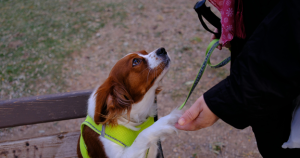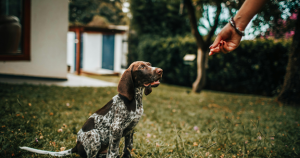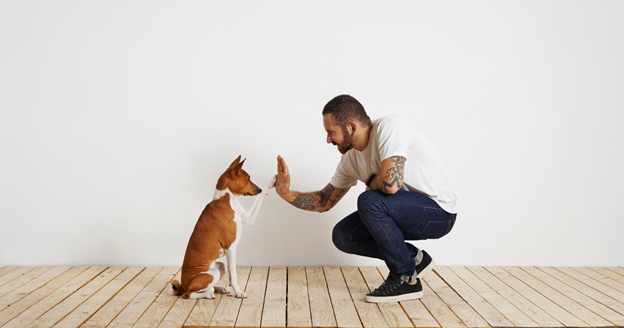Dog Obedience Training Schedule By Age
Having a new pup is nice, but it becomes different when it misbehaves. Learn a dog obedience training schedule you can follow to make your dog obedient.
All dog owners dream of having the perfect puppy. One that’s easily strolling beside you or lying calmly at your feet when you’re outdoors, relaxing.
As good as that sounds, there are specific steps you must take for your pup to be like what you dreamed of.
Steps like making it undergo training to understand what you want. And you need a dog obedience training schedule to achieve this.
Puppies grow and develop fast. Initially, they may experience some discomfort with chewing, potty accidents, nipping, and excessive barking.
But after a couple of weeks, your puppy should start settling into a daily routine.
At this stage, you can introduce some obedience training, which is very important. And if our guess is right, you don’t know what that’s all about.
At Camp Lucky, we provide very effective dog obedience training for all ages in San Antonio.
Our dog obedience training programs stand out because your dog lives with a trainer 24/7, resulting in faster learning and better results.
Now, let’s walk you through the training schedule to follow if you want to try it out on your own.
8-10 Weeks Old
Many new puppy owners bring their puppies home at this age.
This is the stage where they should learn the basics, like their name, good manners at home, some basic commands, and early socialization.
- Help your puppy adjust to a daily schedule that includes their feeding and water times, play and training sessions, potty breaks, and napping times. Potty training for your puppy should start as soon as your puppy comes home. Create a potty schedule to teach your pup where to go in the right spot and how to hold it.
- Crate training is also very valuable for the puppy. It speeds up the housebreaking process and makes the puppy independent. It also reduces separation anxiety.
- This stage is the right time to introduce basic obedience commands, like “Sit & Come.” These are useful commands you’ll likely use for the rest of your puppy’s life. It’s better to introduce these commands during mealtime.
- Start socialization with your family and close friends first. While your puppy is with you, it will meet new people, so make them socialize early to help them form positive connections with family and friends.

10-12 Weeks Old
At this age, you will expand your pup’s training on commands, socialization, and impulse control.
- Introduce more basic obedience commands such as Place, Down, and Heel inside the home, still using food rewards.
- Introduce the leash and harness to your puppy, and let them get used to wearing it around the house while you supervise them.
- Continue socialization by introducing new people to them and letting them meet calm dogs after vaccinations. A safe way to do this is to have your pup in a playpen near the other pup, so they can observe and interact with each other while a barrier is in place.
- Train your puppy on impulse control by making it wait for their food and water bowls. Before putting down their bowls, ask them to sit. Once they are calm, you can put their bowls down and use a word like “Break” or “Okay” to release them from their sitting position.
- Start threshold training by asking your puppy to sit at doorways, open doors, crosswalks, and other similar areas, and then walking through them calmly. This will help discourage your puppy from lunging and pulling each time they see an open doorway to another room, also known as a new adventure to explore, and make your walks calmer.
3-4 Months Old
As your puppy continues to grow, you can start to introduce them to more complex training routines with what they’ve learned.
At this age, do the following:
- Introduce “Stay” and “Leave-It” commands to your puppy!
- Start command combinations and working indoors. Try to increase your puppy’s practice duration by holding their commands longer, for example, a long “Sit” and “Stay.” Also, try to link some commands together.
- Practice Your Heel outdoors in your driveway or on the sidewalk in front of your house to ease them into some of the outside distractions. You may need a higher-value treat if their normal food isn’t working to maintain their focus better!
- After they’ve received all their vaccinations, allow them to have quality time socializing with other new puppies. Don’t force your pup to interact with pups or people they don’t want to, and while they’re at it, monitor them and step in to interrupt when needed, especially during their learning phase.
- If you haven’t, introduce structured play sessions, like fetch and tug. This will also help improve their response to commands like ‘Drop-it,’ ‘Come,’ and ‘Stay’!

4-6 Months Old
This is the age when you should take your puppy outside your home and to public places, so they can start working on their commands and continue socializing.
Take them to new places like the park, and practice their commands and some command combinations.
As your dog improves, start adding distance, duration, and distractions to their command work!
This is a good age to introduce food rewards, praise, or affection when they display the right behavior.
6 Months – 1 Year Old
At this age, your puppy should be familiar with all its basic training.
Now, you’ll continue working with your puppy to strengthen what it has already learned.
Introduce more distance between you and your pup while practicing their commands.
Add in more distractions to have them work through them.
Also, include Recall to train your pup to come back to you from longer distances.
Challenge your pup by bringing them to more populated areas with different distractions for them to work through and improve their skills!
Finally, stick to your schedule and daily training sessions to help your pup maintain what it has learned!
Conclusion
This dog obedience training schedule can help you know when and how to train your new puppy.
All you need to do is be present and committed to ensuring they learn the right behavior.
Don’t look too far for dog obedience training when you’re in San Antonio. Camp Lucky is the top choice near you.
With our 15+ years of experience as a veteran-owned business, we bring discipline, dedication, and care to every dog we train.
Every dog we train stays in a home, not a facility, for a better experience.
Sign up for our dog obedience training program in San Antonio today. Let’s give you a well-behaved dog that follows commands at home and in public.













